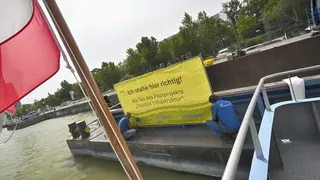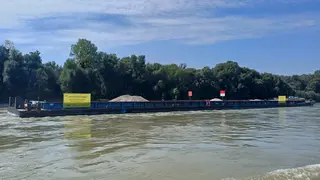Where challenges are "dynamic," solutions must be as well. Following this clear motto, viadonau combines the concept of "flexible infrastructure" to actively influence shipping conditions on the Danube with modern, precise waterway management. On August 27, the pilot project began at the "Rote Werd" ford, a traditionally critical shallow area for Danube navigation.
East of Vienna – Test Area and Specific Field of Application
In Austria, the Danube in its free-flowing section east of Vienna features the most shallow areas. During extended low-water periods, these can quickly become dangerous shallow spots for shipping, which are regularly removed through dredging as part of viadonau's proactive waterway management. The gravel dredged during this process is then reintroduced into the river in an environmentally sound manner. To make the maintenance of the navigation channel more efficient, as well as more effective and demand-oriented, the company aims to integrate "flexible infrastructure" into the range of hydraulic measures within waterway management.
Method and Effect
Unpowered vessels (transport barges) are loaded with gravel from maintenance dredging, positioned outside the navigation channel, and secured with multiple heavy anchors. A push boat is needed to position the loaded barges at the deployment site. By using the barges as flexible infrastructure elements, the Danube water is intended to be directed more into the central navigation channel during low-water periods, where the higher flow speeds will result in fewer gravel deposits, thereby reducing the dredging effort in shallow areas. The grounding of the transport barges on the Danube bed during sinking water levels is an intentional part of this approach. To achieve optimal effect depending on the conditions, up to three connected barges will likely be used in the future. The pilot project, now underway, will run for a period of four years to document and analyse the effects.
International Application Potential and Climate Focus
As part of the recently launched international project FAIRway Danube II, co-financed by the European Union’s Connecting Europe Facility (CEF), the pilot project is expected to provide important insights for implementation in the countries of the middle and lower Danube over the course of the year. The expanded international focus is also based on the global climate challenge. With the progression of climate change, an increase in extreme weather events and more frequent low-water periods are expected. The pilot project will also investigate in practice whether "flexible infrastructure elements" are suitable for responding to climate change effects, thus contributing to the modernization and further development of waterway management in Austria and along the entire Danube.
The transport barges used as "flexible infrastructure elements" are marked according to waterway traffic regulations and equipped with signs indicating that boarding and landing are prohibited.


